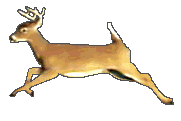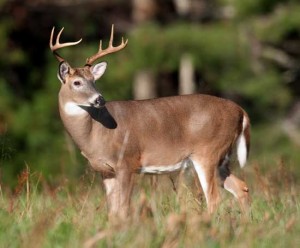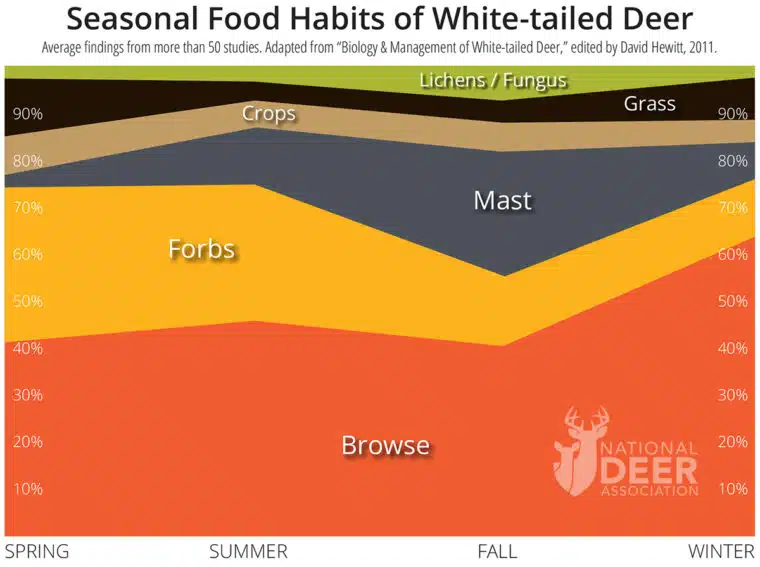Healthy Venison:
According to the USDA, venison is higher in protein, iron and B vitamins than beef and pork. It is also low in cholesterol and free of the antibiotics that are currently infiltrating the commercial meat marked.Deer Life History:
White-tailed deer?s peek breeding occurs in mid November. Deer can breed from mid-September through late February. Fawns are born in the spring (late April to early July) after 200 days gestation with most fawns born around June 1. Does (and occasionally fawns) usually produce a single fawn during their first pregnancy. Twins are typically born in subsequent years in areas with adequate food resources. Triplets may also occur. Female fawns may stay with their mother for two years, males usually leave after a year. Deer have the potential to double their population about every 2.5 years if no mortality takes place. Unhunted deer life spans are from 8 to12 years.
Antlers:
Bucks grow antlers annually, which are used as weapons and in social displays, particularly in relation to reproduction. Bucks begin antler development in April or May. Antlers grow slow at first and then faster near the end of the growing cycle. Antlers are the fastest growing bone and can grow up to 1/2 inch per day. Antler size depends on both age and nutrition. The growing bone is covered with soft velvety material, which nourishes the antler. By August or September antlers are usually fully grown. The bone hardens and the velvet is rubbed off in August to September. Bucks shed their antlers between January and March.
Rubs:
Rubs are caused by deer ‘rubbing’ their antlers on a tree trunk. This strips the bark off the tree and also leaves the deer’s scent on the tree. They do this to ‘mark’ their territory and let does know they are in the area. All bucks occasionally rub saplings less than two inches in diameter, but only older bucks regularly rub trees six or more inches in diameter. Young bucks seldom re-rub the same tree. So, if you happen upon a large-diameter tree that shows signs of frequent rubbing, you can be sure that at least one older, rut-experienced buck is in the area. Mature dominant bucks begin marking their territory soon after losing velvet (around mid September) and continue marking until they cast their antlers in January-March. Yearlings make only about half as many total rubs as prime-age whitetails. Consequently, serious signpost rubbing in September is almost always evidence of a big buck’s presence.
Commonly Eaten Foods:
A deer’s life revolves almost entirely around food. Up to 95 percent of a deer’s active time is spent foraging. Deer consume a variety of vegetative foods and show considerable preferences for individual plants and plant parts. Commonly eaten foods include clover, fruits, nuts, herbs and mushrooms, as well as leaves and stems from trees and shrubs. Acorns are a deer’s favorite food with White Oak acorns being at the top of the list. Deer will also eat farm crops such as corn, soybean, millet and soybean. Deer follow well-used trails to their feeding areas. They usually feed in the early morning hours and in the late afternoon. A deer’s diet will vary according to its habitat and the season. They commonly eat green plants in the summer, corn, soybeans, acorns and other nuts in the fall, and the buds and twigs of woody plants in the winter. Deer are ruminants. Their stomachs have four chambers for digesting their food. This allows them to eat plants that other animals can’t digest. Up to 80 percent of Farm Belt deer’s diet consists of crops during the growing season. However, deer usually remain in forested areas during the day and only venture into the fields toward evening and during the night. The best places to hunt these deer are along travel routes between feeding and bedding areas.
Acorns:
During hunting season deer feed on acorns when available. So you want the oak trees to be dropping a lot of acorns, right? WRONG. Statistics from numerous state agencies have shown that hunter success decreases during years when acorns are abundant. This is possibly due to deer not having to move around as much to find browse, forbs, crops, and other food sources.Size & Coloration:
Adult white-tailed bucks (males) are 3′ to 3.5′ tall at the shoulder and typically weigh 125 to 200 lbs. Does (females) are generally smaller and lighter than the males. Deer are red-brown during summer and grow brown-grey winter coats each fall. Their most conspicuous feature is their tail, which they raise during flight to expose its white underside. Fawns, deer less than one year old, are typically born weighing four to eight lbs. and have red-brown hair covered with numerous white spots. They lose these spots as they grow their first winter coat.
Scent Glands:
White-tailed deer have scent glands on the hooves of all four feet. They also have scent glands on the inside of their rear legs. The scent from these glands are used for identification and during mating season.
Range:
A deer’s home range is usually less than 1 square mile. Deer collect in family groups of a mother and her fawns. When a doe has no fawns, she is usually solitary. Bucks will sometimes run together in groups of 2 or 3, but usually are alone during the rut.? During the rut, bucks will often increase their range looking for hot does.
Sleeping/Resting:
On average through the year, deer spend 70% of their time bedded. This is more than 16 hours a day, although they seldom remain bedded for more than two hours at a time without at least getting up to stretch. Deer almost never go into what we would consider a deep sleep. Deer bed in areas that provide both cover and comfort. A deer usually beds with its back to the wind, allowing it to see anything approaching from downwind and smell upwind danger. On hot, sunny days, deer tend to bed in shady areas. On cold, windy days they’ll find a place that’s protected from the wind. They often rest just over the downwind edge of a ridge. They sometimes return to the same bedding areas and, sometimes, the same beds.
Deer Senses – Sight, Hearing & Smell:
Deer can spot movement in all directions with only a slight turn of the head. Deer receive and process images nearly four times faster than humans particularly at dawn and dusk. This means they are extremely good at detecting even the slightest movement in their visual field. They can see almost as well at night as they can during the day. Deer see oranges and reds as brown or gray. They can see blue nearly 20 times better than humans. Deer also don’t have good depth perception. This is why the often bob their heads when looking for danger. A deer’s eyes can rotate about 50° – in opposite directions – when they lower their heads to the ground to feed. This keeps the pupils aligned with the horizon and maintains the wide field of view even when their nose is pointed downward. Even if the deer’s head is down feeding, it can still see you so don’t move.
Deer have excellent hearing. A deer can rotate its ears to focus in on a sound and determine its direction. Deer hear sounds of a higher frequency than can humans. The flicking of a deer’s ear responding to a sound seems to alert other deer.
A deer’s nose is an amazingly sensitive instrument. Researchers beleive that a deer’s sense of smell can be anywhere from 500 to 1,000 times more acute than a human’s. And around 1/3 better than a dog’s. Furthermore, scientists say that whitetails have thousands of sensitive receptors in their nostrils, which they use to sort out up to six smells at one time. Deer use their uncanny sense of smell to locate food and other deer and to alert them to danger (which inclues you!).
Deer Droppings:
Minimum number of pellets in a pile indicating that the deer producing the droppings was probably a buck is 75. (Not, that I would ever count deer turds! Bahahaha…)


